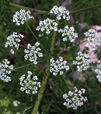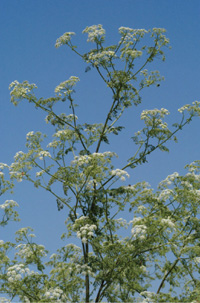

The purple blotches on the stem of poison hemlock give the plant its specific epithet maculatum, or spotted.
DARKNESS, MYSTERY, SUFFERING, bitterness—these are some of the images that we conjure up when we think of wormwood, hemlock, and gall. Are these plants? Products of plants?
Gall, as mentioned in the scriptures, has been translated from several words and in several ways: “He shall flee from the iron weapon, and the bow of steel shall strike him through. It is drawn, and cometh out of the body; yea, the glittering sword cometh out of his gall: terrors are upon him” (Job 20:25, KJV). In that verse, the Hebrew word mererah refers to the bodily fluid gall. In the same chapter, the word is used to indicate the venom of a poisonous snake (Job 20:24–25, KJV).
The word rowsh is also used for a weed: “And so-called justice spreads like a poisonous weed along the furrows of the fields!” (Hosea 10:4, NJB). In fact, in most cases rowsh is likely the product of a plant, as implied through its association with other plants: “Make sure there is no root among you that produces such bitter poison” (Deuteronomy 29:18b, NIV); and, “Their grapes are filled with poison, and their clusters with bitterness” (32:32b, NIV). The next verse in Deuteronomy (32:33) uses a different word for the poison of serpents.
Further evidence linking gall (rowsh) with a plant or plant product occurs in the two references where gall and wormwood are mentioned together: “Make sure there is no man or woman, clan or tribe among you today whose heart turns away from the Lord our God to go and worship the gods of those nations; make sure there is no root among you that produces such bitter poison [rowsh]” (Deuteronomy 29:18, NJB).

Poison hemlock (Conium maculatum) plants about 3 meters (10 feet) tall, in May, along an irrigation ditch near Antakya (biblical Antioch), Turkey. Poison hemlock occurs over a large area of North America in similar wet habitats.

Immature capsule of opium poppy, Papaver somniferum. I incised the capsule so the latex could exude.
In the New Testament, gall is mentioned in only two verses: “For I perceive that thou art in the gall of bitterness, and in the bond of iniquity” (Acts 8:23, KJV, where the Greek chole is translated as “bitterness”); and, “They gave him wine to drink mixed with gall, which he tasted but refused to drink” (Matthew 27:34, NJB, where it is translated “gall”).
Which plant fits the characteristics of gall? It must be both bitter and toxic. According to the New Testament account, it might have a narcotic affect. We can also assume that it is a plant familiar to readers of the original text.
Bitterness is widespread in plants. Many common plants like oak can be bitter. Bitterness can be a means of protecting the plant from grazing or, in more specialized cases, from predation by certain insects. Many plants in the indigenous flora of western Asia are toxic. One plant, however, stands out in its toxicity—poison hemlock (Conium maculatum). (Poison hemlock should not be confused with the common tree known in English as hemlock (Tsuga), which is not toxic and is used to make the original root beer. Early European settlers in North America likened the appearance of the hemlock tree’s leaves to the poisonous plant, freighting this innocuous tree with a frightening name.) Poison hemlock is widespread in the Middle East and Europe, and has been introduced to North America.
Poison hemlock is an herbaceous plant that flowers in the spring and prefers moist habitats. It is common along irrigation ditches. It has many heads consisting of masses of small, white flowers similar to those of the wild carrot (Queen Anne’s lace, Daucus carota), a common weed. Stems have distinctive purple mottling, hence the Latin specific epithet maculatum, meaning mottled. Leaves bear a resemblance to the common carrot (also Daucus carota). The single-seeded fruits (“seeds”) resemble those of carrot, caraway, and cumin, all members of Apiaceae or the carrot family. Because of the resemblance of its fruit and odor to other members of the carrot family, poison hemlock has been accidentally ingested by humans and grazing animals, sometimes with fatal results.
Further supporting evidence that hemlock could be the gall of the Bible is its long history of use, well documented in ancient times. Perhaps the best-known reference is the suicide of Socrates, who drank hemlock. In the description of his dying, he notes losing the feeling in his feet and his hands. This reaction is due to the effect of coniine, a central nervous system poison.
Zohary (1982) suggests that an alternative to hemlock is a group of often toxic plants related to tobacco and tomato—species of the genus Hyoscyamus, most of which grow in very dry areas. One, Hyoscyamus reticulatus, can be found at the margins of fields in western Asia but at a very low frequency.
A less likely plant for gall is the opium poppy, Papaver somniferum, which is apparently not native in Bible lands. Growth of this species in ancient Egypt has not been unequivocally documented (de Vartavan and Amorós 1997). It is sometimes planted as an ornamental in Syria. The fresh latex of this plant is very bitter.
The emphasis in the use and application of gall is its extremely unpleasant taste and poisonous nature. Several plants fit this category, though hemlock, a widespread and common poison plant, is a sturdy candidate.